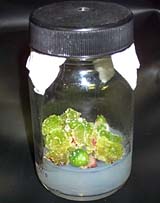Cactus tissue culture. - Shroomery Message Board
(materials from www.shroomery.org/forums/)
Una Here's my first success.
Developing new buds in vitro (photo 1).
Neuro What's your medium and hormone content and ratio?
Una I can not reveal the recipe but if you are interested in cactus tissue culture this letter will give some very usefull tips.
Subject: cacti recepy From: "R. Wellens" rwellens@ZEELANDNET.NL
Date: Tue, 10 Oct 2000 19:43:42 +0200
Reply-To: Plant Tissue Culture PLANT-TC@TC.UMN.EDU
link in internet
Dear Diana,
There is no such thing as a cactus recepy; there is a huge diversity within the cactaceae and almost each different one asks for a different approach. In general (very general!) most species will grow on a 1/2 MS or 1/2 B5 medium supplemented with BA in concentrations varying from 0.1 to 10 mg/l. Some cacti are extremely hard to propagate, for instance the cold-hardy ones from North-America (Sclerocactus, Pediocactus etc.). So are cacti like Ariocarpus, Aztekium etc, the slow growers from Mexico.
Relatively easy are most (not all!!) of the Rebutia's, Mammillaria's, Gymnocalycium's etc. Normally they are multiplied using areole activation. This can be done on the medium described above and is sometimes enhanced by culture in the dark for 2-3 weeks.
You can take pieces of cactus with at least 3-4 areoles and cultivate them in the dark for 3 weeks on the described medium.
When you cannot start from a sterile (seedling) culture and must start with an adult plant you will find it hard to desinfest. Normally if that happens we decide to cut off the biggest spines and sterilize only the top meristem. We use a 2% bleach for a relatively long time (1 hour or more) and shake the culture very frequently. Sometimes we add an dropp of dish-washingsoap to
this or you can use a drop of Tween. You still might find fungal infections, even after a long sterilization. But once you have a single clean cactus you can easily start the multiplicationprocess with areole activation, although you the hard-to-do ones mentioned above will ask a lot of time and effort to do so. Rooting is mostly not a big problem, but again, it is a problem for some species. Rooting for easy species happens on plain 1/2MS without any auxins, but in individual cases an auxin like IBA might be helpful.
A main problem in producing cati is hyperhydricity or vitrification. This can be reduced by using vessels or jars that have air-filtering capacity, not to much because then they dry out. So once you know what type of cactus you are going to multiply you will have to develop its own perfect protocol, which can be based on this information.
However, it is not complete, there are a few articles in which specific cacti were produced with specific techniques. Callus culture or somatic embryogenesis is so far not studied by us and is scarcely found in literature with little success.
I hope this will help you, you can also see some literature on different species. Success with your productions.
Robert Wellens
Succulent Tissue Culture
Neuro Heh i already know how to do cultures and such... Back in school i had this shitty lab every tuesday afternoon and all we did was make cultures.. i was just curious as to your recipe...but if mum's the word, then mum's the word.
DazedSol Very cool Una!!!
Please keep us updated on your progress.......
Hehe, I was gonna ask the same thing as neuro but figured the request would be shot down With good reason though,..there is a lot of money to made on successful culture formula's ....plus all the time done experimenting and all.........thats alot to just give away. Adam.
felixhigh Very very cool UNA! Could you guys please give us more good links on cactus tissue culture? Should i treat them like any other plant then (regarding substrate)?
Una Of course the medium is not MEA.... That's for fungal growth not for plant growth (although malt extraxt is sometimes added to tissue culture media as an 'undefined' growth factor).
The cactus medium is based on Murashige and Skoog (MS) salts, sugar (sucrose), agar and growth regulators.
I've searched for many hours on the internet for info on TC of cactus but there's not much info out there. The link i posted earlier sums up (practically) all the info that is out there.
Whenever i have the time i will go visit the library of the Agricultural University in Wageningen because i'm sure that many scientific articles have been published about the subject that i can get my hands on there.
As for me not wanting to share the exaxt recipe; This is something we might want to take to a commerical scale (sometimes). In fact i studied horticulture for 4 years and i did my final thesis on the development of plant tissue culture protocols.
theshiftingwalls Told you he used agar and malt extract.
Una Here's some more pics..... more (photo 3), developing a new pup (photo 4). Pereskiopsis rooting stage (photo 5).
Neuro Looks good una.. Have you tried producing a callus then growing shoots or roots off the callus in a separate culture?
Agarico Is it possible to do this without aureoles? Just tissue?
Effed Una, you are a true innovator.
Openminded Very, very nice. I've always been fascinated by this sort of tissue culture. I love the way you can simply slice off a bit of something and it will grow into a whole new plant. Well, not quite that simple in practice...
I love growing things, but feel more at home in the lab than in the garden, so this would be a perfect hobby for me!
Please, do keep us informed about your progress. How long did it take for the new shoots to form?
Anand Una: will MushMush sell plant tissue culture supply's in the future? Would be nice.... Don't know where to get the MS and other ingredients.
Una Embryogenesis from callus is possible with many species so i don't see why it's not possible with cacti. Of course you would need a good protocol (which i don't have yet).
The shoots of the SP took 3 weeks to develop.
We will not be selling plant TC supplies since most of the growth regulators that are needed are toxic (carry the skull icon) and these would require special (expensive) transport.
Anand if you are really serious about this is might help you out with some stuff. Or you might contact :info@labassociates.com at http://www.labassociates.com/
Una I set up some pieces yesterday of this cristate/monstrosus pachanoi.
Here's my flow cabinet. Jars wiith medium and sterilised water on the right. Glass bead heater and more sterilised water on the right: photo 6.
Surface sterilisation with bleach (toilet cleaner )
Rinsing with sterile water
The damaged tissue is cut off. And the remaining piece is divided: photo 7.
These pieces are put on the multiplication/initiation medium: photo 8.
No i cross my fingers and hope some of the areoles develop new buds.
--------------------
Here's an update this experiment.
I transferred the pieces to fresh medium and cut away some of the callus. The new shoots are developing steadily: photo 9.
The Trichocereus bridgesii is now also showing some activity: photo 10.
Anonymous Callus yields genetic variation. Bad idea for maintianing cultivars. Good idea for discovering new ones though. Stick with the axillary shoot multiplication for maintaining cultivars, while multiplying them. Those look nice Una.
Research is very limited in cacti microprop. What is out there is usually not reproducible, important info isconvieniently left out of the methodology.
I have some journal studies on the subject of cacti microprop. if you are interested. Explant selection, callus induction, axillary shoot multiplication, somatic embryogenesis, nutritional studies, some specific species studies. There really wasn't much out there as of 1996.
Una photo 11.
Trichocereus pachanoi: photo 12.
DazedSol Hey Una, What kind of lighting do you have those jars under while they grow?
Peace, Adam
Una They grow under simple fluorescent tubes (33/84 cool white)
Una Yesterday i cut up the newly formed shoots. They had been growing for 2 months. Each shoot yielded between 2-4 new sections that were set up on fresh medium. This gave a mean multiplication factor of 7.
If further multiplication goes with that same number in one year 7^5 plants could be obtained. Not 7^6 because the last cycle the plants can not be cut up but should be rooted in a different medium. Still this would mean 16807 plants in one year starting with one explant. Now THAT is rapid multiplication.
Cytokinin concentration seems to influence number of shoots and number of ribs per shoot (higher -> more)
Here's pic: photo 13.
stonErollEr1 And growth would probably be faster if after first initial growth, change lightning into something more powerfull light HPS/MH?[right?]
Peace..
Una Probably not, the atmosphere within the jars does not allow for much assimilation. The medium contains sucrose to supply the plantlets with energy.
The shoots will also develop in the dark but they will remain white/yellow.
stonErollEr1 Yep..this work is just AMAZING..and very very interesting to follow..
Great work UNA..
Peace..
Una I just received a beautiful variegated Tr. peruvianus and i couldn't resist setting up some new explants. We'll see what comes out, variegated, yellow or green shoots...
Here's the tip of the plant: photo 14.
Surface sterilisation of the tip in household bleach on a magnetic stirrer plate. This is followed by three rinses with sterile water: photo 15.
The tip is cut into sections: photo 16.
And these are placed on the medium: photo 17.
Once finished the jars are taped with breathable bandage tape. And yes, those are urine sample jars: photo 18.
Here's some: photo 19.
And some seedlings: photo 20.
My pictures of the failed but they are developing new shoots on almost all areoles. Multiplication can be even faster than those 16,000 per year!

Photo 23.

Photo 24.

Photo 25.

Photo 26.

Photo 27.
| | | | |
Ekstaza Stupendous. I love to see people with great intellect do great things. Una, you are a credit to the human race.
Wonderful
Amazing
Terrific
Outstanding
Yea, I guess that's enough
Una Ok here's a good pic of this. Most all of the areoles are swelling and sprouting new shoots. It's more than a week faster than the initial explants reacted. The plants are adapting to their new environment: photo 21.
And some: photo 22.
just a little update: photo 23.
medicinebag What kind of Base is the culture setting in?
Neuro The explants are on agar with nutrition and hormones.
Una These pic were taken a few weeks ago. The pachanoi is growing very nice in tissue culture. Group photo: photo 24. Close-up: photo 25. Callus cutlure with spontaneous button formation: photo 26. Their habitat: photo 27.
Openminded For anyone that's interested in tissue culture, this page.
Might be a good starting point. It gives the composition of a typical culture medium, briefly describes the roles of the different growth regulators, gives examples of them, etc.
Edit: the ratios etc that they give surely won't be optimised for cacti, but I still think it's a page that is worth reading...
angryjslice This thread is amazing! Bump/question: Una, do you forsee any problems in transfering these back out of the liquid medium there in into soil?
YSr But could you please give a light introduction of some ingredients to start experimenting with? And please give a short description of what IAA and GA is....
Una IAA and GA3 are plant growth regulators - here.
They signal the plant to development in a certain way; shoots, roots, callus etc.
A small introduction to plant tissue culture can be found here.
YSr Do you have some more links to pages where I can read about diffrent mediums for plant tissue cultures? I'm very interested and don't know where to start. Love working with shroom-cultures om agar and liquid karo.
Una http://aggie-horticulture.tamu.edu/tisscult/database/media/index.html
YSr Una, do you recomend any good books?
Una YSr here you go:
Experiments in Plant Tissue Culture by John H. Dodds, Lorin W. Roberts
YSr Una, what about this book? Is it a good investment?
Neuro Ahh yeah, i had forgotten about that.
YSr Where do I buy the hormones? Somebody has a link, please?
I just need about 1 gram of each.
Neuro Chemical supply companies should have them. Fischer, Sigma and the like, i suspect Fischer and Sigma requires some sort of docs but i doubt all of them do depending on what their stock of chems entails.
Phytotech labs should be good http://www.phytotechlab.com
YSr There are a lot of auxins. Which one should I use?
The same about cytokines...
Una Often used cytokinins are BAP and kinetin
Often used auxins are NAA, IAA and IBA. 2,4-D is not often used because it can cause mutations.
The reason why these are used is because all are autoclavable (although some activity might still be lost) and not too costly. It should be noted that IAA loses it's activity in light in about two weeks.
If you don't have a milligram scale i suggest you buy stock solutions (1mg/ml) and use a pipette or syringe for dosage.
As a basal medium i would suggest Murashige&Skoog or Gamborg B5. I use a mixture that contain macro/micro elements and vitamins.
I assume you have a pH meter because the pH of the medium is very important. You can adjust it with 0,1 M NaOH or HCl.
If i have time i will do a more complete write up about the subject, there's just so much worth mentioning.....
Good luck!
YSr I've ordered two of them from Amazon...
PS. От редакции Тематика сервера www.shroomery.org, с которого перенесена статья, накладывает свой отпечаток на объекты, которые выбраны для этой демонстрации. В таком же стиле оформлены и сайт и аватары участников. Вот некоторые из них:

Una

neuro

YSr

Ekstaza

Agarico
| | | | |
Точно также как и рекламный баннер этого сервера: ориентирован на людей, подвинувшихся на грибках:






